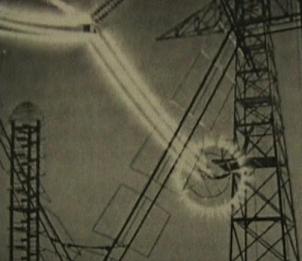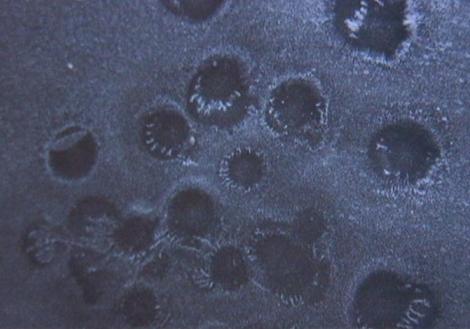for presentation at IEEE's ICOPS 2008 conference. It can be found at this link.
The material below is not at all the final word or conclusive as valid ideas for consideration. I'll be entertaining some
thoughts I hope to bring into the discussion and
if necessary discard but the primary item i intend
to focus on is coronal characteristics of a charged body and their role in formation of features resulting from
a discharge. This may not be a valid point of focus but it is a point of curiosity that has captured my
attention and interest.
What becomes visible need not be formed by something visible.
Be sure to look through these images Which show, in some cases, acculation of material along the same path as material removal, yet concentrated to the central apex and tendril paths.
These two images are greatly revealing of many aspects in a single discharge between two bodies
Images will be the primary tool of the presentation, this time around.
View developing poster here. Or Here is a jpg of the final version of Poster 08
which was placed through the assistance of Jan Weiss and David Schmitz
Additional thanks to Anthony L Peratt for facilitation and independent-confirmation.
Update; Sept 2013, There was a problem in viewing the entire gif image of poster08,, sorry about not seeing it sooner.
SPIDERY SCARS FROM ELECTRIC DISCHARGES
|

Stereo Viewer Image
Note the feature in the upper left corner and it's long tendril at the 4:00 positions. The camparrison with the Mercury image is almost exact. That CRT feature was made with a single dischage whereas the one next to it was made with several.


Left image: 1 million
volt test of power lines which resulted in coronal discharge. Right image: Coronal deposit in material accumulated to locations on upper CRT where one-side of discharges left electro-magnetic signiture. (From 2CRT screen-passage
experiment). The lower screen-features are imaged in top left image above.
This image from A.D. Moorse's book 'Electrostatics' reveals a radial symmetry that is also noted in high energy plasma lab experiments, petroglyphs and other ancient representations associated with celestial events in a distant time (yet to be realized in full). A relationship between coronal discharges and planetary features may not involve any of these observations with the exception of high energy lab experiments which produce the visible characteristics which would not be seen at the low energy level of electrostatic discharges which formed the CRT spider features.
Moore mentions important details of both negative and positive corona. Negative corona has "jumpy streamers" associated with its discharge that are audible as well. Positive corona are smooth, uniform and quiet.
How and if this can be applied to surface features is not yet clear.
|
This image comes from A. L. Peratt's book 'Physics of the Plasma Universe' figure 4.19
In the paragraph 4.6.1 explaining the feature he goes into details that may apply here in reference to Mercury and other features. In reference to the image he explains that "Surface discharges are produced by large electric fields that develop between the surface and subsurface layers in a dielectric material as a consequence of energetic charged-particle deposition.".. .."If the material is an insulator, the space charge will build up at a rate faster than the local relaxation time, and the associated electric field will increase. When the field reaches a critical value that depends on the material, surface smoothness, and porosity, a surface discharge will occur." .. .. "Surface discharges will also occur on natural dielectrics in the solar system when these surfaces are exposed to large fluxes of energetic particles. This condition can be found, for example, where magnetospheric currents interact with the surfaces of the giant planets and their satellites." This link will take you to images similar to what is refered to above and the complete explanation in a separate post. |
|
An interesting detail to consider about Mercury is it's similarity to our moon. In size, it is only 1000 miles larger in diameter, but that is not the primary similarity, it's surface features are so much like the moon's but just a bit more defined. This raises the question "did our moon have a similar relationship with the sun or another star-like body in the past?" You can't go to the astronomical community for that answer, you'd need to consult with a plasma-cosmologist 'and' a comparative mythologist who considers the ancient references to cosmic activity as a valid source of insight into solar system history. You'll be amazed at what the ancients said about the changes to our solar system. Below, you'll find a link to those sources of material.
Getting back to the electrical mechanism which can cause planetary features, this mechanism, Electrical Discharge Machining, has been used in labs to create similar features as those seen on Mercury and elsewhere. The low energy experiments with electrostatic discharge produce the spidery radial features with regularity. To get the type of central crater in the image above, the high energy experiments are needed. The defining line between energy levels is not that absolute, for even at the low energy of an electro static discharge crater features are formed, however they lack molten/elevated aspects. Basic characteristics are the same; trenches, circularity, central and perimeter concentration of material and occasionally radial trenches. These radial trenches are again the focus for now. You may note that the radial features have a softer appearance than the central crater and its largest leader trenches. The sustained discharge, once established will travel around the focal point and jump around in a chaotic manner. It can reach out a tag the surrounding surface with brief contact and produce dished craters. It can also walk across the surface and erode very pronounced trenches but there is a more subtle phase in the moments prior to the intense discharge that can really be appreciated best in low energy electrostatic experiments. Leader strokes reach out with invisible fingers ahead of the major discharge and begin the removal of material in a precise pattern. It happens so fast that slow motion is needed to see the best details. There is no visible arc in the initial interaction, just the movement of material. |


